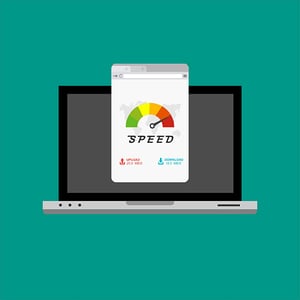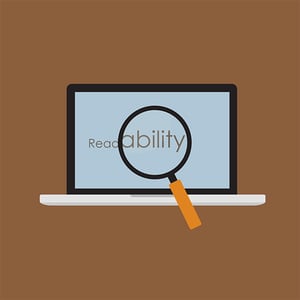![Reduce your page bounce rates with these 7 tips. [graphic] People “raining” on a laptop and bouncing off.](https://www.thecreativemomentum.com/hs-fs/hubfs/blog-files/2007%20batch/2007-05-Bounce%20Rates-image-h.jpg?width=600&name=2007-05-Bounce%20Rates-image-h.jpg) When it comes to landing pages, a bad bounce rate is not a good thing. While high bounce rates can be disheartening, it doesn’t mean that you can’t take steps to fix it.
When it comes to landing pages, a bad bounce rate is not a good thing. While high bounce rates can be disheartening, it doesn’t mean that you can’t take steps to fix it.
Here are seven tips you can use to reduce landing page bounce rates and start converting customers.
Bounce Rate Definition and Measurement
First, let's define exactly what is meant by a bounce rate and what you should be shooting for. At its core, a bounce rate is a simple measurement of the percentage of web page visitors who arrive at your site and then leave without visiting a second page.
If your landing page has a high bounce rate, it means that the page failed to entice the visitor to stay and follow any of the links to continue browsing or purchasing a product. Users bounce when they close a tab, hit the back button, time out or enter a new URL into their browser.
So what is considered a good bounce rate and what is considered bad? Here is a guideline for how average bounce rates are interpreted in the industry:
- 80% and over is considered a bad bounce rate.
- 70 to 80% is considered poor
- 50 to 70% is average.
- 30 to 50% is good.
- 30% and above is excellent.
Now that you know what your bounce rate targets, let's look at how you can improve the bounce rates for your landing pages.
1. Rework and Reposition the Call to Action
A landing page’s core purpose is to direct a user toward a call to action to either make a sale, establish deeper engagement with a user, or learn more about the business. If this isn't happening, it doesn't necessarily mean it's the fault of the landing page. It could be an unconvincing call to action.
If the call to action isn’t engaging with visitors, try rewording it or even repositioning it. Optimize how your users see it and whether it's delivering the information they need to hear.
2. Enhance User Experience Through Design
However, if you find that the call to action you're using works in a different context, it could be a fundamental problem with the website's design. Make sure that the site is responsive across devices and perform an honest assessment as to the strength of the landing page's design.
It may be an unattractive proposition to redesign an important landing page from scratch. Still, failing to do so will mean missed opportunities for the business that the page represents.
3. Improve Backend Speed
While your thoughts might arrive at a problem with the landing page’s content as the culprit, it may in fact be something even more insidious—bad loading times. Google found that 53% of users will leave sites that take more than three seconds to load on a mobile device. If your landing page is not hitting this target, combined with normal abandonment rates, your bounce rates will be abysmal.
Have your developers tighten up your website's backend and carefully measure how quickly the pages load on different devices. A seemingly small fix might have a big impact on your web page's bounce rates.
4. Use Proper Keywords
Content sitting on a landing page will not draw in users by itself. You need to make sure that the text is optimized with the right keywords.
Do your research to find out which keywords best align with your page's intent. And don't stop at the content on the page itself; pay attention to the webpage's meta description that will show up in the actual search result. Google highlights keywords that show up in the meta description and helps drive the visitors you want to convert.
5. Emphasize Readability
While we’re on the subject of text, make sure that visitors can both read and scan it. Your formatting should deliver information to people who are just looking over it and visitors who need more information before they convert.
Break up big blocks of text and make sure that the font and background colors are compatible. And again, make sure your site is optimized across different devices to ensure a good experience for all visitors.
6. Open External Links in a New Tab or
Window
Surprisingly straightforward, bounce rates improve if you are sure to open all external links in a new tab or window. This is because every time visitors leave your webpage, you risk their never returning and lose your chance to reach them with your call to action.
Beyond that, it creates an inconvenience for your visitors. If there are three links that they choose to explore, it means they will have to hit the back button three times just to return to your landing page that they were initially interested in. Opening external links in a new window or tab is a cleaner design that delivers a better user experience.
7. Use High Quality Visuals to Grab Attention
If your call to action and content aren't doing the job, consider adding some visual pizzazz to the site. An engaging video, illustration, or high-quality image can get visitors' attention and help direct it to the content designed to convert.
Make sure that the elements added don't hide the call to action, slow down the site, or interrupt the design. But don't be afraid to add engaging visual elements to make a page more appealing and improve bounce rates.
Reduce Bounce Rates to Enhance Landing Page Effectiveness
By considering the various reasons why your customers are leaving without diving deeper into your web page, you can adjust to reduce bounce rates. Use these tips to increase engagement, find new clients, and convert customers.


![Is your call to action positioned right? [graphic] Large orange button “Call to Action” on laptop screen.](https://www.thecreativemomentum.com/hs-fs/hubfs/blog-files/2007%20batch/2007-05-Bounce%20Rates-image-1-CTA.jpg?width=300&name=2007-05-Bounce%20Rates-image-1-CTA.jpg)


![Visuals help reduce bounce rates. [graphic] Paint buckets, eyedropper sit on a laptop who screen shows three colored boxes and a pen drawing lines.](https://www.thecreativemomentum.com/hs-fs/hubfs/blog-files/2007%20batch/2007-05-Bounce%20Rates-image-4-HighQualityVisuals.jpg?width=300&name=2007-05-Bounce%20Rates-image-4-HighQualityVisuals.jpg)
